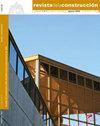Construction and demolition waste as raw material in pavements layers
IF 1.4
4区 工程技术
引用次数: 1
Abstract
The proper management of demolition construction waste from the construction industry is an issue that has gained relevance over the last years in several research centers around the world and, in this context, researches on the potential of using construction and demolition waste to execute pavement layers have been stood out. The paper presented results of a research performed to evaluate the characteristics of the material produced by a waste treatment/beneficiation industrial plant. Tests to verify the suitability of the material as pavement subbase material were performed according Brazilian code - grain-size distribution composition, maximum characteristic dimension, shape particle index (SPI), contaminant percentage and sieving process. The results obtained indicated that the recycled aggregates investigated performed well in all the requirements of the reference standards used and only one correction, related to grain size distribution, was performed using a sieving process. It is important to highlight that the tests and analyses must be performed constantly when forming each aggregate batch, since the recycled aggregates are usually quite heterogeneous, with characteristics that may vary depending on the type of work, construction materials used or period of the year.建筑和拆迁垃圾作为路面层的原料
在过去的几年里,世界各地的几个研究中心都在关注建筑业拆除建筑废物的适当管理问题,在这种情况下,利用建筑和拆除废物来铺设路面的潜力的研究已经脱颖而出。本文介绍了一项研究的结果,该研究旨在评估废物处理/选矿工业工厂生产的材料的特性。根据巴西规范-粒度分布组成、最大特征尺寸、形状颗粒指数(SPI)、污染物百分比和筛分工艺进行了试验,以验证该材料作为路面基层材料的适用性。得到的结果表明,所调查的再生骨料在所用参考标准的所有要求中都表现良好,只有一个与粒度分布有关的校正是使用筛分工艺进行的。必须强调的是,在形成每批骨料时必须不断进行测试和分析,因为回收的骨料通常是异质的,其特性可能因工作类型、使用的建筑材料或一年中的时期而异。
本文章由计算机程序翻译,如有差异,请以英文原文为准。
求助全文
约1分钟内获得全文
求助全文
来源期刊

Revista de la Construccion
工程技术-工程:土木
CiteScore
2.30
自引率
21.40%
发文量
0
期刊介绍:
The Journal of Construction is aimed at professionals, constructors, academics, researchers, companies, architects, engineers, and anyone who wishes to expand and update their knowledge about construction. We therefore invite all researchers, academics, and professionals to send their contributions for assessment and possible publication in this journal. The publications are free of publication charges.
OBJECTIVES
The objectives of the Journal of Construction are:
1. To disseminate new knowledge in all areas related to construction (Building, Civil Works, Materials, Business, Education, etc.).
2. To provide professionals in the area with material for discussion to refresh and update their knowledge.
3. To disseminate new applied technologies in construction nationally and internationally.
4. To provide national and foreign academics with an internationally endorsed medium in which to share their knowledge and debate the topics raised.
 求助内容:
求助内容: 应助结果提醒方式:
应助结果提醒方式:


